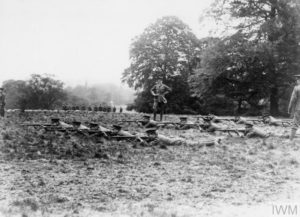Friday August 23rd, 1918
Feel fit today. Asked MO to discharge me. He at first refused to do so but at finish lets me go. When I get back to Battalion find it all rumours. Mad with myself for coming out.
No Home Leave
Despite his desperation to get home on leave, Frank has been sold a pup and there is none in the offing for him or his comrades. Instead, Frank has probably come out of hospital too soon and, as we will see over the coming days, is still suffering from illness.
Tribunals At Home
In the meantime, the tribunals at home are encouraged to ready more men for war. It is clear from newspapers and overall war preparedness, that few in Britain believe the war will end in 1918. Instead the authorities see it lasting into 1919 and continue to ready men and materials for battle.
Ever since conscription was introduced in 1916, there have been tribunals across the country to whom appeals could be made against being called up. Frank himself made such an appeal successfully in 1916. The authorities made significant efforts to harden the backbone of these committees over the years and minimize the number of exemptions granted. There was even a revolt earlier this year in Parliament when the government proposed that men could not have legal representation at tribunal hearings.
Section B of the Volunteer Force
Today, the newspapers report on a new process, outlined in the Military Service Act (No 2) 1918, to be followed when appeals against conscription are upheld. Anyone granted a certificate of exemption shall be now liable to join the Volunteer Force (unless also exempted from this duty by the same tribunal).

The Army Council have announced that two divisions will be formed of Section B of the Volunteer Force. These will be known as Section B (T) and Section B (S). Men’s eligibility for these two units will be determined by their medical classification. Those in class 1 and most of class 2 will be B (T). Those in class 3 will be in B (S) unless only fit for sedentary work. Men who join Section B will have to report for military training.
Recruits to Section B (T) will undertake 14 drills of one hour each a month with a qualifying course of musketry (30 rounds). Once proficient, they will retain these skills with at least 10 drills & some musketry training each month.
Rather differently those in Section B(S) will undertake two hours a week of military duty (eg being on guard). This, the paper notes, will release full time soldiers for ‘more exacting service’. It further notes that it is ‘the tribunal’s responsibility to assign the man appropriately‘.¹
A tough job indeed.
9th Battalion / Manchester Regiment War Diary – 20h August 1918 – Haudricourt
Training and work as per programme, only more musketry was done. 1 OR struck off effective strength after 7 days in hospital with effect from 15-8-18.
References & Further Reading
¹ Article in The Guardian, August 23rd, 1918, page 2
* Q 53719, copyright Imperial War Museums


